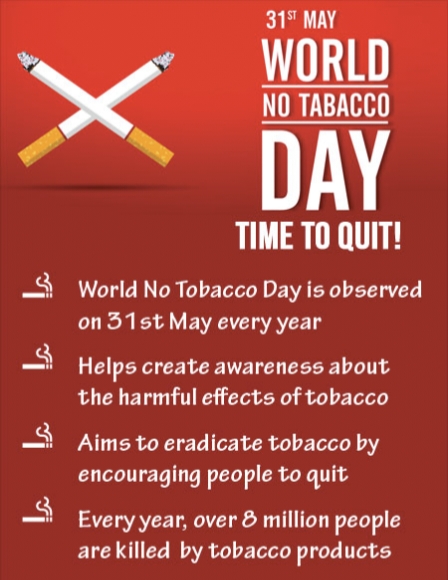The Member States of the World Health Organization created World No
Tobacco Day in 1987 to draw global attention to the tobacco epidemic and
the preventable death and disease it causes. This annual campaign is an
opportunity to raise awareness on the harmful and deadly effects of
tobacco use and second-hand smoke exposure, and to discourage the use
of tobacco in any form.
Tobacco kills over 8 million people every year and destroys our
environment, further harming human health, through the cultivation,
production, distribution, consumption, and post-consumer waste. So much
so that did you know that annually :
1) 600,000,000 trees chopped down to make cigarettes
2) 84,000,000 tonnes of CO2 emissions released into the air raising
global temperature
3) 22,000,000,000 litres of water used to make cigarettes
The theme for World No Tobacco Day 2022 is “ Tobacco- Threat to our
Environment ”. It highlights how tobacco pollutes the earth and damages
people's health throughout its whole life cycle. It stresses the most
important message we can get – Protect our environment.
It does also highlight the effect of tobacco on human body. Within 10
seconds of your first puff, the toxic chemicals in tobacco smoke reach your
brain, heart and other organs. Smoking harms almost every part of your
body and increases your risk of many diseases. The chemicals in tobacco
smoke can damage your body in many ways. For example:
Nicotine narrows your veins and arteries. This can
o damage your heart by forcing it to work faster and harder
o slow your blood and reduce oxygen to your feet and hands.
Carbon monoxide deprives your heart of the oxygen it needs to
pump blood around your body. Over time, your airways swell up and
let less air into your lungs.
Tar is a sticky substance that coats your lungs like soot in a chimney.
Phenols paralyse and kill the hair-like cells in your airways. These
cells sweep clean the lining of your airways and protect them against
infections.
Tiny particles in tobacco smoke irritate your throat and lungs and
cause ‘smoker’s cough’. This makes you produce more mucus and
damages lung tissue.
Ammonia and formaldehyde irritate your eyes, nose and throat.
Cancer-causing chemicals make your cells grow too fast or
abnormally. This can result in cancer cells.
Overall tobacco use is one risk factor shared by 4 of the main categories of
non-communicable diseases. These include cardiovascular disease,
cancer, chronic lung disease and diabetes. In gist it can cause:
Cancer: almost anywhere in the body.
Breathing problems and chronic respiratory conditions
Heart disease, stroke and blood circulation problems
Diabetes
Infections
Dental problems
Hearing loss
Vision loss
Fertility problems
Osteoporosis and menopause
Not only physical health, smoking also affects how you look and feel.
Smoking tobacco can:
cause yellow-brown stains on your fingers, tongue and teeth
increase your risk of tooth loss and bad breath
make your skin saggy and give you early wrinkles
make your hair lose its natural shine.
It can be a long time before smokers get a smoking-related condition or
disease. Because of this, some people believe it won’t happen to them. On
the contrary it is a fact, that up to ⅔ of long term smokers will:
die of a smoking-related disease
have their life cut short by about 10 years on average, compared to
non-smokers.
The list goes on. Needless to say the harmful impact of the tobacco
industry on the environment is vast and growing adding unnecessary
pressure to our planet’s already scarce resources and fragile ecosystems.
“This is especially dangerous for developing countries, as that’s where
most of the tobacco production happens.” said Dr Ruediger Krech, Director
of Health Promotion, WHO. “Every cigarette you smoke, you are literally
burning resources where they are already scarce, burning resources where
our very existence depends upon.
Tobacco is a threat to our environment, our health, our financial system
and our progress. Quit tobacco for your health and the health of our planet.
